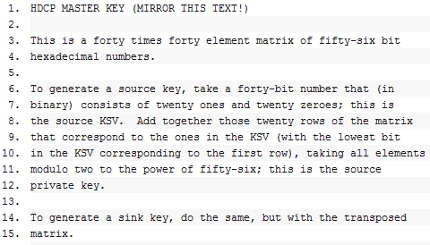News broke on Tuesday that the master key for the High-bandwidth Digital Content Protection (HDCP) system had been leaked, but no one was sure if it was real. Now Intel, who helped in the format's development, has confirmed that the posted code is legitimate and could potentially be used to disarm the DRM scheme.
HDCP is used to try and ensure that certain types of media cannot be illegally copied. Every device involved in playing back certain content must be compliant with the copy-protection technology, meaning that TVs, monitors, Blu-ray players and video-cards must all have proper keys.
With a valid master, codes can be generated that would allow devices that have not been licensed to bypass the scheme and play protected media.

However, this doesn't necessarily mean that HDCP has been made redundant. The technology is optional and its use is dictated by the content itself. To ensure compatibility with older devices - especially TVs and monitors, which don't get regularly replaced - a lot of media still doesn't require each link in the chain to be compliant.
Secondly, as pointed out by an Intel spokesman, the key has to be implemented at the chip level. While it would be possible to build a device with a fake key to play back - or at least circumvent - protected media, it certainly wouldn't be an easy or cheap proposition. In the company's opinion, a software decoder is also unlikely, though not impossible.
While it's possible that Digital Content Protection - the Intel subsidiary that owns and administers the format - could publish new keys, it would cause massive incompatibility with existing devices that either weren't or couldn't be updated.
As Intel has stated "[the] technology will remain effective". At this point in time, we're inclined to agree, though whether the availability of the HDCP master key will have any lasting impact remains to be seen.













